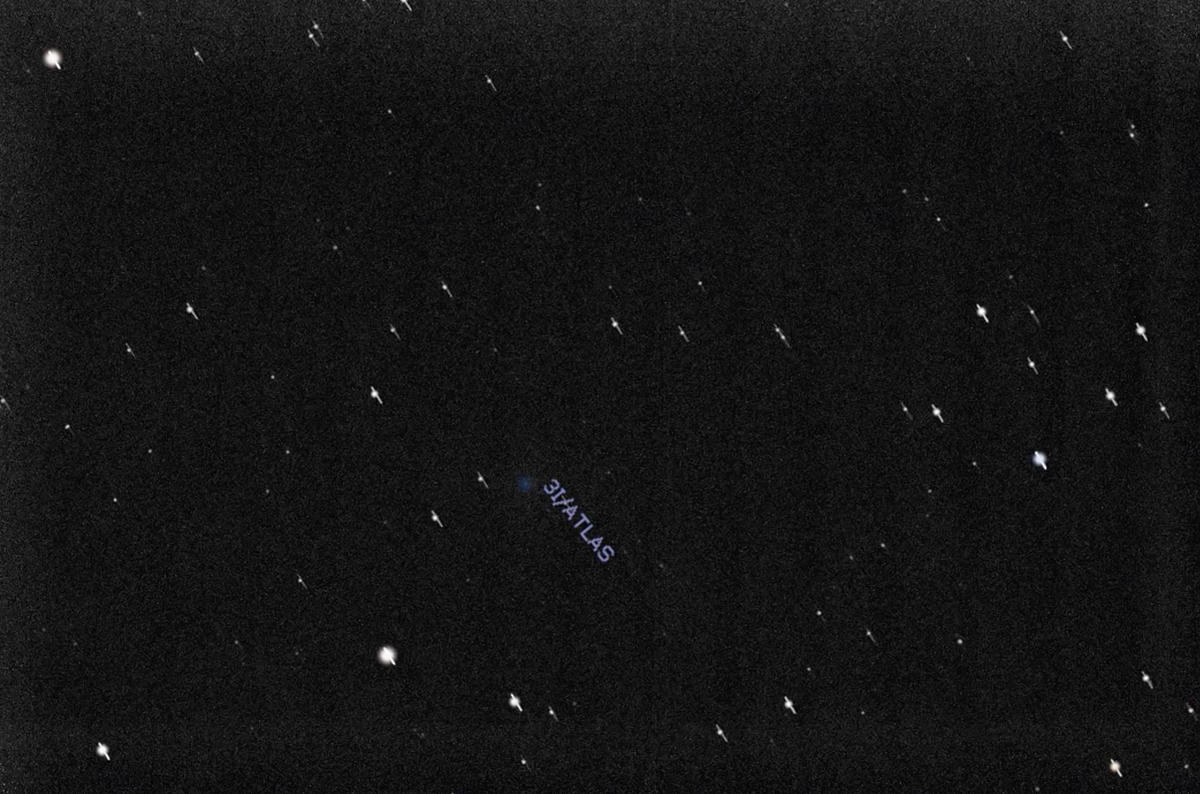![]() Press enter or click to view image in full size
Press enter or click to view image in full sizeStacking images from the Mastcam-Z camera on the Perseverance rover on Mars shows a faint smudge where 3I/ATLAS was expected to be in the Martian sky. (Credit: NASA/JPL-Caltech/ASU/Simeon Schmauß)
In a new interview on Newsmax last night (available here), I discussed the seven anomalies of the interstellar object 3I/ATLAS. My segment was shared with Rep. Tim Burchet, a member of the House Committee on Oversight and Accountability. Following this interview, the deputy chief of staff for policy at the White House, Stephen Miller, discussed in a separate news segment (available here) the U.S. government shutdown, and was asked during his interview whether the U.S. President was briefed about 3I/ATLAS.
So far, no data from human-made Mars orbiters was publicly released by NASA or ESA. In a subsequent podcast interview with Brian Keating (accessible here), I mentioned anecdotally that the astrophotographer Simeon Schmauß stacked publicly-available images from the Mastcam-Z camera onboard NASA’s Perseverance rover on Mars and reported here a faint smudge at the location where 3I/ATLAS was expected to appear on the Martian sky.
Yesterday, October 3, 2025, was a special day, as 3I/ATLAS reached its closest approach to Mars at a separation of 29 million kilometers. This should have allowed multiple Mars orbiters to capture new imaging and spectroscopic data on 3I/ATLAS, as follows:
1. The High Resolution Imaging Experiment (HiRISE) camera onboard NASA’s Mars Reconnaissance Orbiter (MRO) should have taken images with a spatial resolution of 30 kilometers per pixel, the highest yet for 3I/ATLAS. The brightest pixel in these images can be used to infer the diameter of the nucleus of 3I/ATLAS, currently expected to be larger than 5 kilometers (as inferred here).
2. The High-Resolution Stereo Camera (HRSC) as well as the OMEGA and SPectroscopy for the Investigation of the Characteristics of the Atmosphere of Mars (SPICAM) spectrometers onboard ESA’s Mars Express are expected to capture lower-resolution images and spectroscopic data on 3I/ATLAS.
3. The Colour and Stereo Surface Imaging System (CaSSis) and the NOMAD spectrometer onboard ESA’s ExoMars Trace Gas Orbiter (TGO), are expected to produce color images and composition data. The Infrared Spectrometer for ExoMars (ISEM) can be used to analyze the chemical composition of the plume of gas around 3I/ATLAS.
4. The Imaging Ultraviolet Spectrograph (IUVS) onboard NASA’s MAVEN spacecraft can provide UV imaging and spectroscopy of 3I/ATLAS.
5. Additional images and spectroscopic data are expected from the Moderate Resolution Imaging Camera (MoRIC) onboard China’s Tianwen-1 as well as the Emirates eXploration Imager (EXI) and Emirates Mars Infrared and Ultraviolet Spectrometers (EMIRS and EMUS) onboard the Hope Orbiter of UAE’s Emirates Mars Mission.
We are fortunate to benefit from the passage of an unusually massive and bright interstellar object (at least a thousand times more massive than the previous two: 1I/`Oumuamua and 2I/Borisov) in the inner solar system through an orbit that is aligned with the ecliptic plane of the planets around the Sun (with a random likelihood of order 0.2%) and that is timed for a close passage near Mars, Venus and Jupiter (with a likelihood of 0.005%). Whether these extremely rare coincidences are a matter of random chance or extraterrestrial intelligent planning remains to be seen by the Mars orbiters. Based on the data their images and spectrographs provide, humanity will know whether it should be grateful to mother nature or to the intelligence of a cosmic sibling.
ABOUT THE AUTHOR
Press enter or click to view image in full size(Image Credit: Chris Michel, National Academy of Sciences, 2023)
Avi Loeb is the head of the Galileo Project, founding director of Harvard University’s — Black Hole Initiative, director of the Institute for Theory and Computation at the Harvard-Smithsonian Center for Astrophysics, and the former chair of the astronomy department at Harvard University (2011–2020). He is a former member of the President’s Council of Advisors on Science and Technology and a former chair of the Board on Physics and Astronomy of the National Academies. He is the bestselling author of “Extraterrestrial: The First Sign of Intelligent Life Beyond Earth” and a co-author of the textbook “Life in the Cosmos”, both published in 2021. The paperback edition of his new book, titled “Interstellar”, was published in August 2024.

